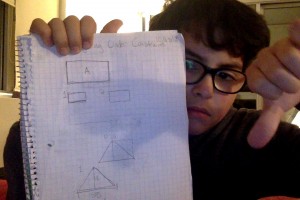Name: Ben C. Humanities
7th Grade Comparative Essay
Outline for Crucible/McCarthy Comparative Essay
Theme: Racism
Paragraph #1: Introductory Paragraph (GIT)
Grabber Statement (G): ISIS took responsibility for 9/11, and since they affiliate with Islam, people develop a prejudice against all Muslims. When those people gain power, it can lead to deportation, terrible treatment, and unfair jailing. What are you supposed to think?
Introduction of Theme (I): Racism is a problem that appears throughout history. It can lead to unfair treatment, hysteria, fear, chaos, and death. Friends become terrorists and neighbors become witches. From the Salem Witch Trials, to the McCarthy Era and current day, it seems to never stop ruining lives and making terrible history.
Thesis Statement (T): Racism can cripple the peace and order of a society. Racism happens when people need someone to blame, so they oppress a group of people who may not have as much power.
_________________________________________________________________________
Paragraph #2: Crucible Thematic Connection
Topic Sentence (T): Racism in the Crucible is primarily displayed through the treatment of Tituba and how quickly she’s accused of witchcraft.
Explanatory Sentence (E): The play the Crucible showcases the racism that took place during the Salem Witch Trials of the 1690’s. Tituba is the first person accused because she’s a black woman who possess’ little power and no social status. Parris and Abigail use their power and racism in the following section.
Evidence (E):
“Parris: I saw Tituba waving her arms over the fire when I came to you. Why was she doing that? And I heard a screeching and gibberish coming from her mouth. She were swaying like a dumb beast over that fire!
Abigail: She always sings her Barbados songs, and we dance.” (Pg.64)
Analysis (A): This quote shows Parris and Abigail dehumanizing Tituba because she’s black and disempowered. Their treatment of Tituba is extremely racist and terrible. Abigail scapegoats Tituba to take the blame off of herself, because she doesn’t want to lose the slight bit of respect she has and be held responsible for “witchcraft”. Parris even says Tituba swayed over the fire like a beast, which is dehumanization.
Concluding/ Transition (C): The Crucible was a horrible time, even though it was more sexism, it still shows the theme of racism. But racism became more of a problem when there is at least some twisted proof, which is what happened in the McCarthy Era.
__________________________________________________________________________
Paragraph #3: McCarthy/Red Scare Thematic Connection
Topic Sentence (T): Racism was a huge problem that caused complete hysteria and chaos in the McCarthy Era as well.
Explanatory Sentence (E): The McCarthy Era was fueled on racism. Russians were persecuted for being from Russia even if they didn’t affiliate with communism. Because of the racism that took place during the McCarthy Era, America became a madhouse in which no one felt safe. People hid under desks for bomb drills and treated Russians terribly. People in power were the most racist, as you can see in this quote.
Evidence (E): “His first major raid rounded up hundreds of suspected radicals. Nearly 250 of them were deported back to their homeland. Many of the deportees had not done anything wrong. Their only crime was belonging to an organization that was viewed as radical.” (Pg.20)
Analysis (A): Russians in the USA were sent back to their homeland, even though they had done nothing wrong, only because they were Russian. This persecution was on their ethnic and racial background. They might have disagreed with communism, yet they were sent back to Russia. This is racism at its greatest. Major racism appears through history. It is natural to be fearful of difference, but it shouldn’t lead to unfair treatment and death.
Concluding/ Transition (C): Now this theme of sending people back to their homeland is happening again, and the McCarthy Era is repeating itself in current day.
__________________________________________________________________________
Paragraph #4: Modern Day Witch Hunt Thematic Connection
Topic Sentence (T): Racism is at its most in modern day because of people like Donald Trump.
Explanatory Sentence (E): People are still racist to this day, because there parents raised them that way, and their parents before them and so on. It’s a never ending cycle until someone breaks it and isn’t racist. The racism that is happening right now is terrible. People like Donald Trump are going to far and affecting millions of people’s lives. One example of this can be seen in this quote from a news article.
Evidence (E): “President Trump’s most recent executive order effectively bans citizens of seven Muslim-majority countries from entering the U.S. for at least 90 days — but some Muslim countries were spared from the order’s blacklist, even though they have deep-seated ties to terrorism.” (NY News)
Analysis (A): Trump banned Muslims, even though he claims it’s not a ban. He categorizes Muslims as terrorists. Since ISIS affiliates with Islam, they fooled people like Trump into hating Muslims. Now racist people like Trump are making Muslims think America is a terrible place which shows how racism comes back and bites you.
Concluding/ Transition (C): Racism is a big problem throughout history that needs to be stopped. We look back at history and say how it’s different now, but it’s not. It just seems like that which is why it happens. If racism is not interfered, it will ruin peoples lives, which is terrible.
__________________________________________________________________________
Paragraph #5: Concluding Paragraph (ROC)
Reflection on Thesis (R): You wonder why people with power can be so racist and not feel bad, or even stop. History is going to repeat itself if no one does anything, yet the people who don’t seem to realize are the ones causing the problem.
Overview of Main Points (O): Race is something people should be proud of, and not something you hide to fit in. Race should not be hated on, but loved. If everyone wasn’t never racist, imagine how different history would have been. Racism fuels hysteria and chaos, yet people don’t stop being racist, as if the tragic moments in history never happened.
Concluding Idea (C): Racism shows how powerful words are, and how they can change people’s lives. From people like Tituba, to the Rosenbergs, and Muslims deported back to their home country, a world without racism would have changed their lives for the better, so why isn’t that possible?



